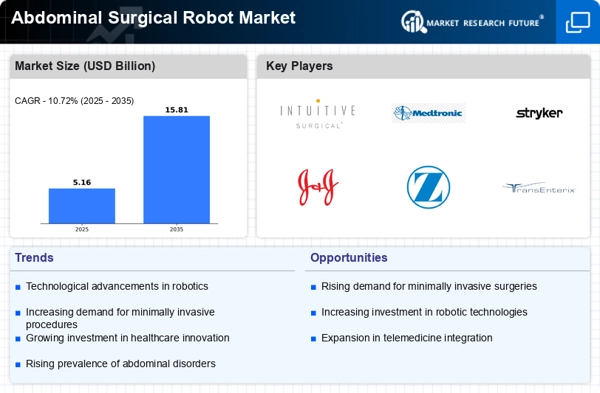Technological Advancements in Robotics
The Abdominal Surgical Robot Market is experiencing a surge in technological advancements that enhance surgical precision and efficiency. Innovations such as improved imaging systems, enhanced robotic arms, and advanced software algorithms are transforming surgical procedures. For instance, the integration of artificial intelligence and machine learning is enabling robots to assist surgeons in real-time decision-making. According to recent data, the market for surgical robots is projected to grow at a compound annual growth rate of approximately 20% over the next five years. This growth is driven by the increasing adoption of robotic-assisted surgeries, which are associated with reduced recovery times and lower complication rates. As technology continues to evolve, the Abdominal Surgical Robot Market is likely to witness further enhancements that could redefine surgical practices.
Collaborative Innovations in Surgical Robotics
The Abdominal Surgical Robot Market is experiencing a wave of collaborative innovations among technology companies, healthcare providers, and research institutions. These collaborations are aimed at developing next-generation surgical robots that incorporate cutting-edge technologies such as augmented reality and haptic feedback. By pooling resources and expertise, stakeholders are able to accelerate the development of advanced robotic systems that enhance surgical capabilities. Recent partnerships have led to the introduction of new robotic platforms that offer improved functionality and user experience. As these innovations continue to emerge, the Abdominal Surgical Robot Market is likely to expand, driven by the demand for more sophisticated and effective surgical solutions that can address complex medical challenges.
Rising Preference for Minimally Invasive Surgery
The Abdominal Surgical Robot Market is significantly influenced by the rising preference for minimally invasive surgical techniques. Patients and healthcare providers are increasingly opting for procedures that minimize trauma, reduce pain, and shorten recovery times. Robotic-assisted surgeries offer enhanced precision and control, which are critical in delicate abdominal procedures. Data indicates that minimally invasive surgeries have seen a substantial increase, with a reported 30% rise in procedures performed using robotic systems in recent years. This trend is expected to continue, as more hospitals and surgical centers invest in robotic technologies to meet patient demands. Consequently, the Abdominal Surgical Robot Market is poised for growth as it aligns with the broader shift towards patient-centric care and improved surgical outcomes.
Increased Investment in Healthcare Infrastructure
The Abdominal Surgical Robot Market is benefiting from increased investment in healthcare infrastructure across various regions. Governments and private entities are recognizing the importance of advanced surgical technologies in improving healthcare delivery. This investment is often directed towards acquiring state-of-the-art surgical robots and training healthcare professionals in their use. Recent statistics suggest that healthcare spending is projected to rise by 5% annually, with a significant portion allocated to surgical innovations. As healthcare facilities upgrade their infrastructure, the demand for robotic-assisted surgeries is likely to increase, thereby propelling the growth of the Abdominal Surgical Robot Market. This trend indicates a commitment to enhancing surgical capabilities and improving patient outcomes through advanced technology.
Growing Awareness and Acceptance of Robotic Surgery
The Abdominal Surgical Robot Market is witnessing a growing awareness and acceptance of robotic surgery among both patients and healthcare providers. Educational initiatives and successful case studies are contributing to a better understanding of the benefits associated with robotic-assisted procedures. Patients are increasingly informed about their surgical options and are more likely to choose robotic surgery due to its advantages, such as reduced scarring and faster recovery. Surveys indicate that approximately 70% of patients express a preference for robotic-assisted surgery when informed about its benefits. This shift in perception is likely to drive demand within the Abdominal Surgical Robot Market, as more healthcare providers adopt robotic systems to meet patient expectations and improve surgical outcomes.


















Leave a Comment